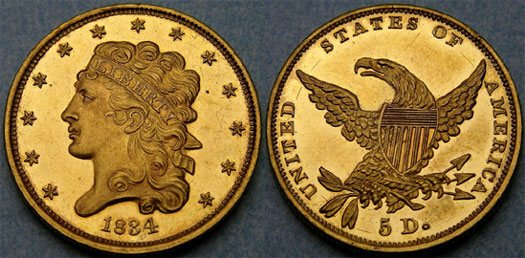Classic Head Half Eagles
Source: My Coin Guides: The introduction of the Classic Head Half Eagle coincided with a significant change for the American gold denominations. Under the Mint Act of 1834, both the weight and purity of the of the coins was reduced enough to make the bullion value less than the face value. Unlike the previous two decades when the majority of freshly minted half eagles were immediately exported and melted for their gold content, the denomination began to circulate within domestic commerce. As a result, this type is much more available compared to previous series, especially in lower grades. However, the more extensive circulation did have the impact of making survivors in uncirculated condition much more scarce.

After discontinuing the production of the eagle or ten dollar gold piece in 1804, the largest denomination produced by the United States Mint was the half eagle or five dollar gold piece. It had been struck in reasonable quantities for most years since its introduction in 1795, but due to the the high intrinsic and face value of the coins, they were not usually seen in commerce. The coins did circulate among banks, although even this was limited, as most pieces were exported overseas and melted upon arrival. Payments in high value were usually made using a wide array of paper money, in literally thousands of different varieties and from the same number of banks. Some of these banks would fail soon after they had printed the notes, which were not backed by gold or silver. The Mint Act of June 28, 1834 would bring things back into balance by reducing the metal content of the two gold denominations and thus allowing them to circulate more readily.
A new design was created for the half eagle by William Kneass to go along with the change in specifications. His obverse design contained a different interpretation of Liberty than seen in the previous type. She is still facing left, but has a notably younger appearance. Rather than a cap, she now wears a simple headband inscribed “LIBERTY”. Curly hair can be seen, with two locks extending on her neck and face. Thirteen stars, evenly spaced are continuously around, and the date appears below.
The reverse design remained virtually identical to the previous type, with an American bald eagle seen from the front with its wings spread. The eagle has a shield at its breast and holds an olive branch and bundle of three arrows in its talons. “UNITED STATES OF AMERICA” is around, with the first and last word separated by the ends of the wing. The denomination is directly under the eagle, and appears as “5 D.” The one significant change to the reverse design was the removal of the motto “E PLURIBUS UNUM” which had previously appeared on a scroll above the eagle.
Little over a month after the approval of the change in specifications, the Philadelphia Mint struck and paid out the first of the new half eagles. In the remaining months of the year, the total output of the Philadelphia Mint reached the enormous number of 657,460 half eagles, almost triple the highest annual mintage for the denomination up until this time. While the production levels would decline over the next few years, the output and extent of circulation was much higher than the Mint had anticipated. As such, the change in weight could be considered a success. Branch Mints were opened in the Southern United States in 1837 and 1838. These, in time, would also start to strike this denomination, causing widespread acceptance even in the rural areas of the United States.
The Classic Head Half Eagles were struck at the southern Branch Mints for only two different issues. The mints located in Charlotte, North Carolina and Dahlongea, Georgia would both turn out a limited number of half eagles in 1838, among the first mint marked issues struck by the United States Mint. The combined mintage of the two issues was a little over 10% of the production from the Philadelphia Mint that year, making them true key dates of the short lived series, which was replaced with a new design in 1839.
Further rarities come in the form of Proof strikings, made for presentation purposes or at the request of influential coin collectors at the time, whose count was extremely low. While mintages are unconfirmed for many of the issues, it is generally believed that the total number of Proof strikings of this type did not exceed a fifteen to eighteen individual coins. The status of some pieces is disputed, although the correct classification probably is “specimen-striking” for the majority of these. The most available of these is the first date, of which as many as six Proof strikings are known to exist. Both 1837 and 1838 Proofs are unique, and those of 1835 and 1836 are represented by only three or four examples each.
